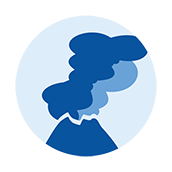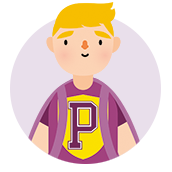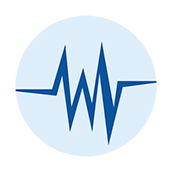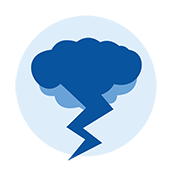Learn about volcanic activityHe ako mō te hūnga
 New Zealand is on the Ring of Fire, a geographic belt encircling the Pacific Ocean. This ring contains about 90% of the Earth’s volcanoes.
New Zealand is on the Ring of Fire, a geographic belt encircling the Pacific Ocean. This ring contains about 90% of the Earth’s volcanoes.
On this page
What is a volcano?
Volcanoes come in different shapes and sizes. There are three main types found in New Zealand.
- Cone volcanoes, such as Mounts Ruapehu, Taranaki and Ngauruhoe
- Volcanic fields, such as the Auckland Volcanic Field, which has about 50 volcanoes
- Calderas such as Lakes Taupō and Rotorua.
Volcanoes erupt when pressure builds up inside the Earth. The pressure forces molten rock (magma) towards the surface. New Zealand volcanoes have different levels of activity. Whakaari | White Island is busy all the time. Some volcanoes can have hundreds, or or even thousands of years between eruptions.
The type of eruption depends on the amount of gases in the magma and the silica content. The amount of gas determines how explosive the eruption will be. The silica content determines how runny the eruption will be.
Some eruptions are explosive, blowing out great volumes of rocks and molten material. Other volcanoes erupt in flows, pouring out clouds of hot gas mixed with streams of liquid lava.
People living in volcanic regions are at risk from ash, debris and lava flows. The eruption of Mount Tarawera in 1886 killed around 106 people. When there is a crater lake or torrential rain, water can mix with volcanic debris to form a swiftly-moving avalanche of mud called a lahar. A lahar swept off Mount Ruapehu in 1953 and killed 151 people in the Tangiwai railway disaster.
It is important to know what to do before, during and after a volcanic eruption. The most frequent volcanic hazard is ash. Ash can travel a long way depending on the wind. It can cause health problems for people and animals and damage buildings and cars. A lot of ash can be very heavy.
What do we do before volcanic activity?
- Know where active volcanoes are and whether they are likely to affect you.
- Have an evacuation plan — where to go and how to get there.
- Store water as water supplies may become polluted. Keep your empty water and fizzy drink bottles. Give them a good clean and fill them with water — you need three litres of water for each person for at least three days. Don’t forget to store water for babies and pets too.
What do we do during volcanic activity?
- Close all doors and windows and stay indoors.
- If you are outside near an eruption, shelter in a car or building.
- If you are outside in volcanic ashfall, wear a dust mask (rated P2 or N95) or cover your mouth and nose with a cloth.
- Listen to the radio. Follow the instructions of emergency services and keep out of restricted areas.
What do we do after a volcanic eruption?
- If you are in a safe place — stay put.
- Listen to the radio for information.
- Return home only when told to do so.
Find out more about what to do before, during and after a volcanic eruption.
Home learning
 Have you seen the GeoNet volcano cameras? Ask an adult to help you to download an image and then share it with your class.
Have you seen the GeoNet volcano cameras? Ask an adult to help you to download an image and then share it with your class.
Make a plan with your family to get through an emergency. Think about the things you need every day and work out what you would do if you didn't have them.
Make your plan — print it out, stick it on the fridge and make sure everyone knows the plan.
Find out about volcanic activity and eruptions that have happened in your region.

See New Zealand's volcano cameras and the current volcanic unrest in New Zealand.
Learning resources

Visit this virtual field trip from Learnz. In this field trip, experts will take you to remote locations to help you better understand what causes natural disasters.

Visit this virtual field trip from Learnz. In this field trip, you will see how people live, work and play on the slopes of Mt Ruapehu, coping with the risk of volcanic activity.

Watch this video on volcanoes produced by National Geographic.

Read a New Zealand perspective on volcanoes on Te Ara, the Encyclopedia of New Zealand.

Watch this video from the Science Learning Hub explaining rock cores.

Watch these YouTube videos from GeoNet experts answering questions about natural hazards.
Learn about emergencies
Natural hazards can be frightening. They can strike at any time and often without warning. Explore the types of emergencies below and learn better ways to prepare.






